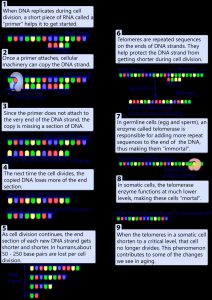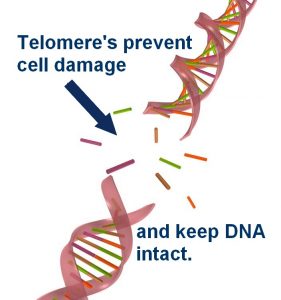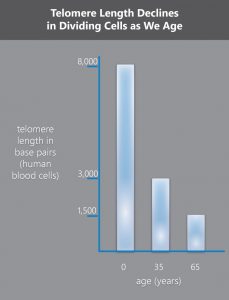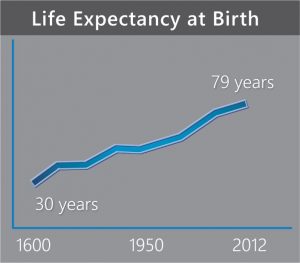Posted by Jack
Last night I listened to a Nobel prize winner talk about her research on telomeres from the 1970’s. You probably have never heard of a telomere before, but its something very important found on the end of your chromosomes. On going research into telomeres is giving us miraculous insight into curing major diseases (including cancer) plus allowing us to live healthier, longer lives. As a result of my personal discovery I woke up early this morning, determined to find out more about telomeres and pass it along to you.
The bottom line here is simple, we each have the power to do many things that can enhance telomeres and that will enhance our lives. Exercise, good nutrition of course. Maintaining a healthy weight, these are all helpful. But, there is a high likelihood there may be over the counter vitamins we can use to bolster the telomeres and all of this could add up to many healthy, productive years to your life. Researchers are also working on ways to use natural occurring telomerase to protect telomeres. Now isn’t this discovery worth reading the following article? You bet!
 Telomeres are repetitive stretches of DNA located at the ends of linear chromosomes. They protect the ends of chromosomes in a manner similar to the way the tips of shoelaces keep them from unraveling.
Telomeres are repetitive stretches of DNA located at the ends of linear chromosomes. They protect the ends of chromosomes in a manner similar to the way the tips of shoelaces keep them from unraveling.
In many types of cells, telomeres lose a bit of their DNA every time a cell divides. Eventually, when all of the telomere DNA is gone, the cell cannot replicate and dies.
White blood cells and other cell types with the capacity to divide very frequently have a special enzyme that prevents their chromosomes from losing their telomeres. Because they retain their telomeres, such cells generally live longer than other cells.
Telomeres also play a role in cancer. The chromosomes of malignant cells usually do not lose their telomeres, helping to fuel the uncontrolled growth that makes cancer so devastating.
Each time a cell divides, the telomeres get shorter. When they get too short, the cell can no longer divide; it becomes inactive or “senescent” or it dies. This shortening process is associated with aging, cancer, and a higher risk of death. So telomeres also have been compared with a bomb fuse.
Like the rest of a chromosome, including its genes, telomeres are sequences of DNA — chains of chemical code. Like all DNA, they are made of four nucleic acid bases: G for guanine, A for adenine, T for thymine, and C for cytosine.
Telomeres are made of repeating sequences of TTAGGG on one strand paired with AATCCC on the other strand. Thus, one section of telomere is a “repeat” made of six “base pairs.”
In white blood cells, the length of telomeres ranges from 8,000 base pairs in newborns to 3,000 base pairs in adults and as low as 1,500 in elderly people. (An entire chromosome has about 150 million base pairs.) Each time it divides, an average cell loses 30 to 200 base pairs from the ends of its telomeres.
Cells normally can divide only about 50 to 70 times, with telomeres getting progressively shorter until the cells become senescent or die.
Telomeres do not shorten in tissues where cells do not continually divide, such as heart muscle.
Without telomeres, the main part of the chromosome — the part with genes essential for life — would get shorter each time a cell divides. So telomeres allow cells to divide without losing genes. Cell division is necessary for growing new skin, blood, bone, and other cells.
Without telomeres, chromosome ends could fuse together and corrupt the cell’s genetic blueprint, possibly causing malfunction, cancer, or cell death. Because broken DNA is dangerous, a cell has the ability to sense and repair chromosome damage. Without telomeres, the ends of chromosomes would look like broken DNA, and the cell would try to fix something that wasn’t broken. That also would make them stop dividing and eventually die.
die.
An enzyme named telomerase adds bases to the ends of telomeres. In young cells, telomerase keeps telomeres from wearing down too much. But as cells divide repeatedly, there is not enough telomerase, so the telomeres grow shorter and the cells age.
Telomerase remains active in sperm and eggs, which are passed from one generation to the next. If reproductive cells did not have telomerase to maintain the length of their telomeres, any organism with such cells would soon go extinct.
As a cell begins to become cancerous, it divides more often, and its telomeres become very short. If its telomeres get too short, the cell may die. Often times, these cells escape death by making more telomerase enzyme, which prevents the telomeres from getting even shorter.
Many cancers have shortened telomeres, including pancreatic, bone, prostate, bladder, lung, kidney, and head and neck.
Measuring telomerase may be a way to detect cancer. And if scientists can learn how to stop telomerase, they might be able to fight cancer by making cancer cells age and die. In one experiment, researchers blocked telomerase activity in human breast and prostate cancer cells growing in the laboratory, prompting the tumor cells to die. But there are risks. Blocking telomerase could impair fertility, wound healing, and production of blood cells and immune system cells.
Geneticist Richard Cawthon and colleagues at the University of Utah found shorter telomeres are associated with shorter lives. Among people older than 60, those with shorter telomeres were three times more likely to die from heart disease and eight times more likely to die from infectious disease.
While telomere shortening has been linked to the aging process, it is not yet known whether shorter telomeres are just a sign of aging — like gray hair — or actually contribute to aging.
If telomerase makes cancer cells immortal, could it prevent normal cells from aging? Could we extend lifespan by preserving or restoring the length of telomeres with telomerase? If so, would that increase our risk of getting cancer?
Scientists are not yet sure. But they have been able to use telomerase in the lab to keep human cells dividing far beyond their normal limit, and the cells do not become cancerous.
If we used telomerase to “immortalize” human cells, we may be able to mass produce cells for transplantation, including insulin-producing cells to cure diabetes, muscle cells for treating muscular dystrophy, cartilage cells for certain kinds of arthritis, and skin cells for healing severe burns and wounds. An unlimited supply of normal human cells grown in the laboratory would also help efforts to test new drugs and gene therapies.
Some long-lived species like humans have telomeres that are much shorter than species like mice, which live only a few years. Nobody knows why. But it’s evidence that telomeres alone do not dictate lifespan.
Cawthon’s study found that when people are divided into two groups based on telomere length, the half with longer telomeres lives an average of five years longer than those with shorter telomeres. This study suggests that lifespan could be increased five years by increasing the length of telomeres in people with shorter ones.
People with longer telomeres still experience telomere shortening as they age. How many years might be added to our lifespan by completely stopping telomere shortening? Cawthon believes 10 years and perhaps 30 years.
 After age 60, the risk of death doubles every 8 years. So a 68-year-old has twice the chance of dying within a year compared with a 60-year-old. Cawthon’s study found that differences in telomere length accounted for only 4% of that difference. And while intuition tells us older people have a higher risk of death, only 6% is due purely to chronological age. When telomere length, chronological age, and gender are combined (women live longer than men), those factors account for 37% of the variation in the risk of dying over age 60. So what causes the other 63%?
After age 60, the risk of death doubles every 8 years. So a 68-year-old has twice the chance of dying within a year compared with a 60-year-old. Cawthon’s study found that differences in telomere length accounted for only 4% of that difference. And while intuition tells us older people have a higher risk of death, only 6% is due purely to chronological age. When telomere length, chronological age, and gender are combined (women live longer than men), those factors account for 37% of the variation in the risk of dying over age 60. So what causes the other 63%?
A major cause of aging is “oxidative stress.” It is the damage to DNA, proteins, and lipids (fats) caused by oxidants, which are highly reactive substances containing oxygen. These oxidants are produced normally when we breathe, and also result from inflammation, infection, and consumption of alcohol and cigarettes. In one study, scientists exposed worms to two substances that neutralize oxidants, and the worms’ lifespan increased an average 44%.
Another factor in aging is “glycation.” It happens when glucose, the main sugar we use as energy, binds to some of our DNA, proteins, and lipids, leaving them unable to do their jobs. The problem becomes worse as we get older, causing body tissues to malfunction, resulting in disease and death. Glycation may explain why studies in laboratory animals indicate that restricting calorie intake extends lifespan.
Most likely oxidative stress, glycation, telomere shortening, and chronological age — along with various genes — all work together to cause aging.
People with a disease named dyskeratosis congenita have telomeres that get short much more quickly than normal. These people endure premature aging and death. They face a higher risk of life-threatening infections, leukemia and other blood cancers, intestinal disorders, cirrhosis of the liver, and pulmonary fibrosis, a deadly stiffening of lung tissue. They also are more likely to endure gray hair, balding, poor wound healing, spots on the skin, intestinal disorders, softening of the bones, and learning disabilities. The implication is that telomeres may play a role in all those conditions, because they all involve tissues in which cells divide often. There also is some evidence linking shortened telomeres to Alzheimer disease, hardening of the arteries, high blood pressure, and type 2 diabetes.
Human lifespan has increased considerably since the 1600s, when the average lifespan was 30 years. By 2012, the average US life expectancy was nearly 79. Reasons for the increase include sewers and other sanitation measures, antibiotics, clean water, refrigeration, vaccines and other medical efforts to prevent children and babies from dying, improved diets, and better health care.
Some scientists predict average life expectancy will continue to increase, although many doubt the average will ever be much higher than 90. But a few say vastly longer lifespans are possible.
Cawthon says that if all processes of aging could be eliminated and oxidative stress damage could be repaired, “one estimate is people could live 1,000 years.”
Here is a link to show you how you can take control and enhance your telemeres.
Miscellaneous links that may be helpful:
https://www.genome.gov/26524120/
http://learn.genetics.utah.edu/content/basics/telomeres/
Note: Our boomer generation may be the first generation to see a decline in the average life expectancy due to complication in obesity.

Note: Being the only “developed” economy on the planet that does not provide universal access to preventative medicine may also have something to do with this decline in life expectancy. You think?
Your beloved Demorats had control of the White House, the House and the Senate and they passed your beloved Obammycare. So what the heck are you crying about?
If left in the hands of progressives we’d still be dying at aged thirty!
Jack”s article included the reason our lives have been prolonged and it’s capitalism and innovation which produced: “…sewers and other sanitation measures, antibiotics, clean water, refrigeration, vaccines and other medical efforts to prevent children and babies from dying, improved diets, and better health care.
You lefties have no appreciation for this incredible contribution to our lives.
Jack, with people like Libby running California we will have shorter lifespans.
If for whatever reason you can no longer get behind the state of Jefferson could you get behind this:
Now Nigel Farage and the ‘Bad Boys of Brexit’ set their sights on splitting California in two
Nigel Farage and Leave backer Arron Banks just returned from a trip to California
They helped raise $1million for a ‘Calexit’, which would split California in two
They appear to be pitting the eastern, more rural side of California against the western ‘coastal elite’ liberals in Los Angeles and San Francisco
http://www.dailymail.co.uk/news/article-4350388/Nigel-Farage-s-Bad-Boys-Brexit-look-Calexit.html
Maybe this has a better chance?
Let them split, let them split! In fact let them just go away to fend for themselves. I predict they will be Greece in a matter of a few years if not sooner.
It’s not a let. They won’t go for it. They want to suck the resources out of the rest of state. They will take us all down with them if we don’t make them split.
Good luck…so far we haven’t had much luck. However, if it were their idea…..
Lefties always need to take the credit.
More interesting tech—-
Batteries—
http://bayourenaissanceman.blogspot.com/2017/03/the-successor-to-lithium-ion-batteries.html
3D printing—
http://weaponsman.com/?p=40098